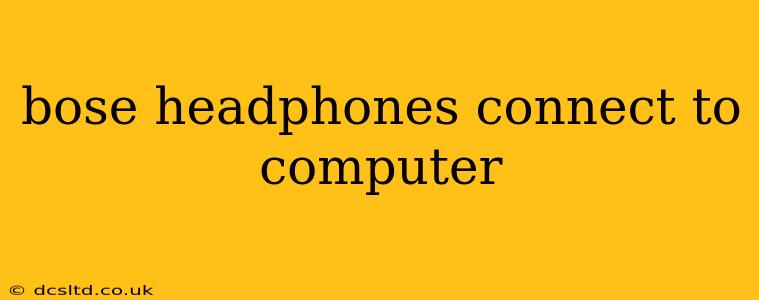Connecting your Bose headphones to your computer might seem straightforward, but there are nuances depending on your headphone model and computer operating system. This guide will walk you through various connection methods, troubleshooting common issues, and answering frequently asked questions to ensure a seamless audio experience.
How Do I Connect My Bose Headphones to My Computer?
The connection process depends largely on the type of Bose headphones you own. Generally, you'll use one of these methods:
-
Bluetooth: Most modern Bose headphones connect wirelessly via Bluetooth. Simply put your headphones into pairing mode (usually by holding down the power button for a few seconds), search for available Bluetooth devices on your computer, select your Bose headphones from the list, and follow any on-screen prompts to complete the pairing.
-
Wired Connection (3.5mm): Some Bose headphones include a 3.5mm audio cable. Simply plug one end into the headphone jack on your headphones and the other into the audio jack on your computer. This method provides a reliable connection, especially for situations where low latency is critical, such as gaming.
-
USB Connection: Certain Bose models, especially those designed for professional use or gaming, might use a USB connection for both audio and power. Plug the USB connector into your computer; the headphones should automatically be recognized.
Choosing the Right Connection Method:
-
Bluetooth: Ideal for convenience and mobility, but can experience slight audio latency.
-
Wired (3.5mm): Offers reliable audio quality with minimal latency, perfect for gaming and professional audio work.
-
USB: Provides both audio and power, often with advanced features like noise cancellation control.
Why Won't My Bose Headphones Connect to My Computer?
Several issues can prevent your Bose headphones from connecting to your computer. Let's troubleshoot the common problems:
-
Bluetooth Issues: Ensure Bluetooth is enabled on your computer. Check your computer's Bluetooth settings to ensure no other devices are interfering. Restart both your headphones and computer. Try forgetting the device on your computer and pairing again.
-
Driver Problems: Outdated or corrupted audio drivers can interfere with the connection. Updating your computer's audio drivers can often resolve this issue. This process varies depending on your operating system; consult your computer's documentation or manufacturer's website for instructions.
-
Headphone Issues: Ensure your Bose headphones are fully charged (if applicable). Check for any physical damage to the connection ports. Try resetting your headphones to factory settings if possible. Refer to your Bose headphone manual for specific instructions on resetting your device.
-
Incorrect Input Selection: Make sure your computer's audio output is correctly set to your Bose headphones. Check your computer's sound settings to confirm that the headphones are selected as the audio output device.
How Do I Fix Bluetooth Connectivity Problems with My Bose Headphones?
As mentioned earlier, several factors can affect Bluetooth connectivity. Here's a breakdown of solutions:
-
Restart your devices: This simple step often resolves temporary glitches.
-
Check Bluetooth range: Ensure your headphones are within range of your computer's Bluetooth adapter.
-
Remove other Bluetooth devices: Interference from other devices can disrupt the connection.
-
Update your computer's Bluetooth drivers: Outdated drivers can cause incompatibility issues.
-
Reset your headphones: This might resolve software glitches within the headphones themselves.
Can I Use My Bose Headphones for Zoom Meetings on My Computer?
Yes, you can use your Bose headphones for Zoom meetings on your computer. Simply connect your headphones using Bluetooth or a wired connection (as detailed above), and select your Bose headphones as the audio input and output devices within the Zoom application's settings.
My Bose Headphones Sound Muffled When Connected to My Computer. What Should I Do?
Muffled sound often points to incorrect audio settings on your computer. Check your system's volume levels, ensuring both the overall volume and the application volume are adequately set. Verify that no other audio enhancements or equalizers are applied that might be reducing the sound quality. Check your headphones’ settings too, as some Bose headphones have built-in EQ.
This comprehensive guide provides a starting point for resolving common Bose headphone connection issues. If you continue to experience problems, consult your Bose headphone manual for specific troubleshooting steps or contact Bose customer support directly. Remember to always check for updates to your Bose headphones' firmware and your computer's operating system for optimal performance.
